Low-Cost Broadband Circularly Polarized Array Antenna with Artificial Magnetic Conductor for Indoor Applications
Abstract
1. Introduction
2. Antenna Design and Analysis
2.1. Antenna Structure
2.2. Design of CP Antenna Unit
2.3. AMC Structure Design and Analysis
3. Results’ Comparisons
4. Conclusions
Author Contributions
Funding
Institutional Review Board Statement
Informed Consent Statement
Data Availability Statement
Conflicts of Interest
References
- Wang, Z.; Liang, T.; Dong, Y. Metamaterial-Based, Compact, Wide Beam-Width Circularly Polarized Antenna for 5G Indoor Application. Microw. Opt. Technol. Lett. 2021, 63, 2171–2178. [Google Scholar] [CrossRef]
- Lee, K.F.; Tong, K.F. Microstrip Patch Antennasbasic Characteristics and Some Recent Advances. Proc. IEEE 2012, 100, 2169–2180. [Google Scholar]
- Hall, P.S. Application of Sequential Feeding to Wide Bandwidth, Circularly Polarised Microstrip Patch Arrays. IEE Proc. H Microw. Antennas Propag. 1989, 136, 390–398. [Google Scholar] [CrossRef]
- Jiang, Y.; Geyi, W.; Yang, L.; Sun, H. Circularly-Polarized Focused Microstrip Antenna Arrays. IEEE Antennas Wirel. Propag. Lett. 2016, 15, 52–55. [Google Scholar] [CrossRef]
- Lines, T.; Lin, S.; Lin, Y. A Compact Sequential-Phase Feed Using Uniform Transmission Lines for Circularly Polarized Sequential-Rotation Arrays. IEEE Trans. Antennas Propag. 2011, 59, 2721–2724. [Google Scholar]
- Li, Y.; Zhang, Z.; Feng, Z. A Sequential-Phase Feed Using a Circularly Polarized Shorted Loop Structure. IEEE Trans. Antennas Propag. 2013, 61, 1443–1447. [Google Scholar] [CrossRef]
- Yang, W.; Zhou, J.; Yu, Z.; Li, L. Bandwidth- and Gain-Enhanced Circularly Polarized Antenna Array Using Sequential Phase Feed. IEEE Antennas Wirel. Propag. Lett. 2014, 13, 1215–1218. [Google Scholar] [CrossRef]
- Deng, C.; Li, Y.; Zhang, Z.; Feng, Z. A Wideband Sequential-Phase Fed Circularly Polarized Patch Array. IEEE Trans. Antennas Propag. 2014, 62, 3890–3893. [Google Scholar] [CrossRef]
- Wang, L.; Zhu, Z.; En, Y. Performance Enhancement of Broadband Circularly Polarized Slot-Microstrip Antenna Using Parasitic Elements. IEEE Antennas Wirel. Propag. Lett. 2021, 20, 2255–2259. [Google Scholar] [CrossRef]
- Ding, K.; Gao, C.; Yu, T.; Qu, D.; Zhang, B. Gain-Improved Broadband Circularly Polarized Antenna Array with Parasitic Patches. IEEE Antennas Wirel. Propag. Lett. 2017, 16, 1468–1471. [Google Scholar] [CrossRef]
- Mohammadi-Asl, S.; Nourinia, J.; Ghobadi, C.; Majidzadeh, M. Targeting Wideband Circular Polarization: An Efficient 2 × 2 Sequentially-Phase-Fed Rotated Array Antenna. Radioengineering 2018, 27, 79–84. [Google Scholar] [CrossRef]
- Rafii, V.; Nourinia, J.; Ghobadi, C.; Pourahmadazar, J.; Virdee, B.S. Broadband Circularly Polarized Slot Antenna Array Using Sequentially Rotated Techniquefor C-Band Applications. IEEE Antennas Wirel. Propag. Lett. 2013, 12, 128–131. [Google Scholar] [CrossRef]
- Deng, C.; Li, Y.; Zhang, Z.; Feng, Z. A Wideband Isotropic Radiated Planar Antenna Using Sequential Rotated L-Shaped Monopoles. IEEE Trans. Antennas Propag. 2014, 62, 1461–1464. [Google Scholar] [CrossRef]
- Karamzadeh, S.; Rafii, V.; Kartal, M.; Ucan, O.N.; Virdee, B.S. Circularly Polarised Array Antenna with Cascade Feed Network for Broadband Application in C-Band. Electron. Lett. 2014, 50, 1184–1186. [Google Scholar] [CrossRef]
- Ta, S.X.; Park, I. Compact Wideband Sequential-Phase Feed for Sequentially Rotated Antenna Arrays. IEEE Antennas Wirel. Propag. Lett. 2017, 16, 661–664. [Google Scholar] [CrossRef]
- Eskandari, H.; Booket, M.R.; Kamyab, M.; Veysi, M. Investigations on a Class of Wideband Printed Slot Antenna. IEEE Antennas Wirel. Propag. Lett. 2011, 9, 1221–1224. [Google Scholar] [CrossRef]
- Karamzadeh, S.; Rafii, V.; Saygin, H.; Kartal, M. Polarisation Diversity Cavity Back ReconFigureurable Array Antenna for C-Band Application. IET Microw. Antennas Propag. 2016, 10, 955–960. [Google Scholar] [CrossRef]
- Siahcheshm, A.; Nourinia, J.; Ghobadi, C.; Karamirad, M.; Mohammadi, B. A Broadband Circularly Polarized Cavity-Backed Archimedean Spiral Array Antenna for C-Band Applications. AEU—Int. J. Electron. Commun. 2017, 81, 218–226. [Google Scholar] [CrossRef]
- Bisharat, D.J.; Liao, S.; Xue, Q. Wideband Unidirectional Circularly Polarized Antenna with L-Shaped Radiator Structure. IEEE Antennas Wirel. Propag. Lett. 2017, 16, 12–15. [Google Scholar] [CrossRef]
- Chung, K.L.; Li, Y.; Zhang, C. Broadband Artistic Antenna Array Composed of Circularly-Polarized Wang-Shaped Patch Elements. AEU—Int. J. Electron. Commun. 2017, 74, 116–122. [Google Scholar] [CrossRef]
- Maddio, S. A Compact Wideband Circularly Polarized Antenna Array for C-Band Applications. IEEE Antennas Wirel. Propag. Lett. 2015, 14, 1081–1084. [Google Scholar] [CrossRef]
- Dong, Y.; Itoh, T. Metamaterial-Based Antennas. Proc. IEEE 2012, 100, 2271–2285. [Google Scholar] [CrossRef]
- Technologies, W.; Ale, J.; Highway, A.; Atlasbaf, Z. New Ku-Band Reflectarray Antenna by Using Anisotropic Superstrate on an Artificial Magnetic Conductor. Int. J. Microw. Wirel. Technol. 2016, 9, 831–841. [Google Scholar]
- Ta, S.X.; Park, I. Compact Wideband Circularly Polarized Patch Antenna Array Using Metasurface. IEEE Antennas Wirel. Propag. Lett. 2017, 16, 1932–1936. [Google Scholar] [CrossRef]
- Chen, Q.; Zhang, G.; He, C.; Fan, Y.; Zhu, Z.; Zhang, D.; Li, J.; Zhao, Y. Wideband and High-Gain Circularly-Polarized L-Shaped Slot Antenna Array Using Metamaterial. Int. J. Microw. Wirel. Technol. 2021, 13, 359–364. [Google Scholar] [CrossRef]
- Yang, W.; Meng, Q.; Che, W.; Gu, L.; Xue, Q. Low-Profile Wideband Dual-Circularly Polarized Metasurface Antenna Array with Large Beamwidth. IEEE Antennas Wirel. Propag. Lett. 2018, 17, 1613–1616. [Google Scholar] [CrossRef]
- Ta, S.X.; Park, I. Planar Wideband Circularly Polarized Metasurface-Based Antenna Array. J. Electromagn. Waves Appl. 2016, 30, 1620–1630. [Google Scholar] [CrossRef]
- Zhao, Z.H.; Zhang, H.F. A Wide-Band Circularly Polarized Antenna Array Using a Sequential Phase Feed Structure Applied to 5G-Band. J. Electromagn. Waves Appl. 2021, 35, 2141–2152. [Google Scholar] [CrossRef]
- Polarized, L.C.; With, A.; Enhancement, G.; Zheng, Q.; Guo, C.; Vandenbosch, G.A.E.; Ding, J. Reduction Using Polarization Conversion EBG Structures. IEEE Trans. Antennas Propag. 2020, 68, 2440–2445. [Google Scholar]
- Li, K.; Liu, Y.; Jia, Y.; Guo, Y.J. A Circularly Polarized High-Gain Antenna with Low RCS over a Wideband Using Chessboard Polarization Conversion Metasurfaces. IEEE Trans. Antennas Propag. 2017, 65, 4288–4292. [Google Scholar] [CrossRef]
- Feng, D.; Zhai, H.; Xi, L.; Yang, S.; Zhang, K.; Yang, D. A Broadband Low-Profile Circular-Polarized Antenna on an AMC Reflector. IEEE Antennas Wirel. Propag. Lett. 2017, 16, 2840–2843. [Google Scholar] [CrossRef]
- Cao, Y.F.; Zhang, X.Y.; Mo, T. Low-Profile Conical-Pattern Slot Antenna with Wideband Performance Using Artificial Magnetic Conductors. IEEE Trans. Antennas Propag. 2018, 66, 2210–2218. [Google Scholar] [CrossRef]
- Jiang, X.; Zhang, Z.; Li, Y.; Feng, Z. A Low-Cost Wideband Circularly Polarized Slot Array with Integrated Feeding Network and Reduced Height. IEEE Antennas Wirel. Propag. Lett. 2016, 15, 222–225. [Google Scholar] [CrossRef]
- Xu, R.; Li, J.; Kun, W. A Broadband Circularly Polarized Crossed-Dipole Antenna. IEEE Trans. Antennas Propag. 2016, 64, 4509–4513. [Google Scholar] [CrossRef]
- Pan, C.Y.; Chen, H.Y. Circularly Polarized Sequentially Rotated Antenna Array for Dual-Band WLAN Applications. Int. J. RF Microw. Comput. Eng. 2021, 31, e22590. [Google Scholar] [CrossRef]
- Siahcheshm, A.; Nourinia, J.; Ghobadi, C. Circularly Polarized Antenna Array with a New Sequential Phase Feed Network Utilizing Directional Coupler. AEU—Int. J. Electron. Commun. 2018, 93, 75–82. [Google Scholar] [CrossRef]
- Gao, X.; Tian, G.; Shou, Z.; Li, S. A Low-Profile Broadband Circularly Polarized Patch. IEEE Antennas Wirel. Propag. Lett. 2021, 20, 214–218. [Google Scholar] [CrossRef]
- Lin, J.; Zhu, L. Low-Profile High-Directivity Circularly-Polarized Differential-Fed Patch Antenna with Characteristic Modes Analysis. IEEE Trans. Antennas Propag. 2020, 69, 723–733. [Google Scholar] [CrossRef]
- Zeng, J.; Member, G.S.; Liang, X.; Member, S.; He, L. Single-Fed Triple-Mode Wideband Circularly. IEEE Trans. Antennas Propag. 2022, 70, 846–855. [Google Scholar] [CrossRef]
- Zeng, J.; Member, G.S.; Zhang, Z. Penta-Mode Ultrawideband Circularly. IEEE Trans. Antennas Propag. 2022, 70, 9051–9060. [Google Scholar] [CrossRef]
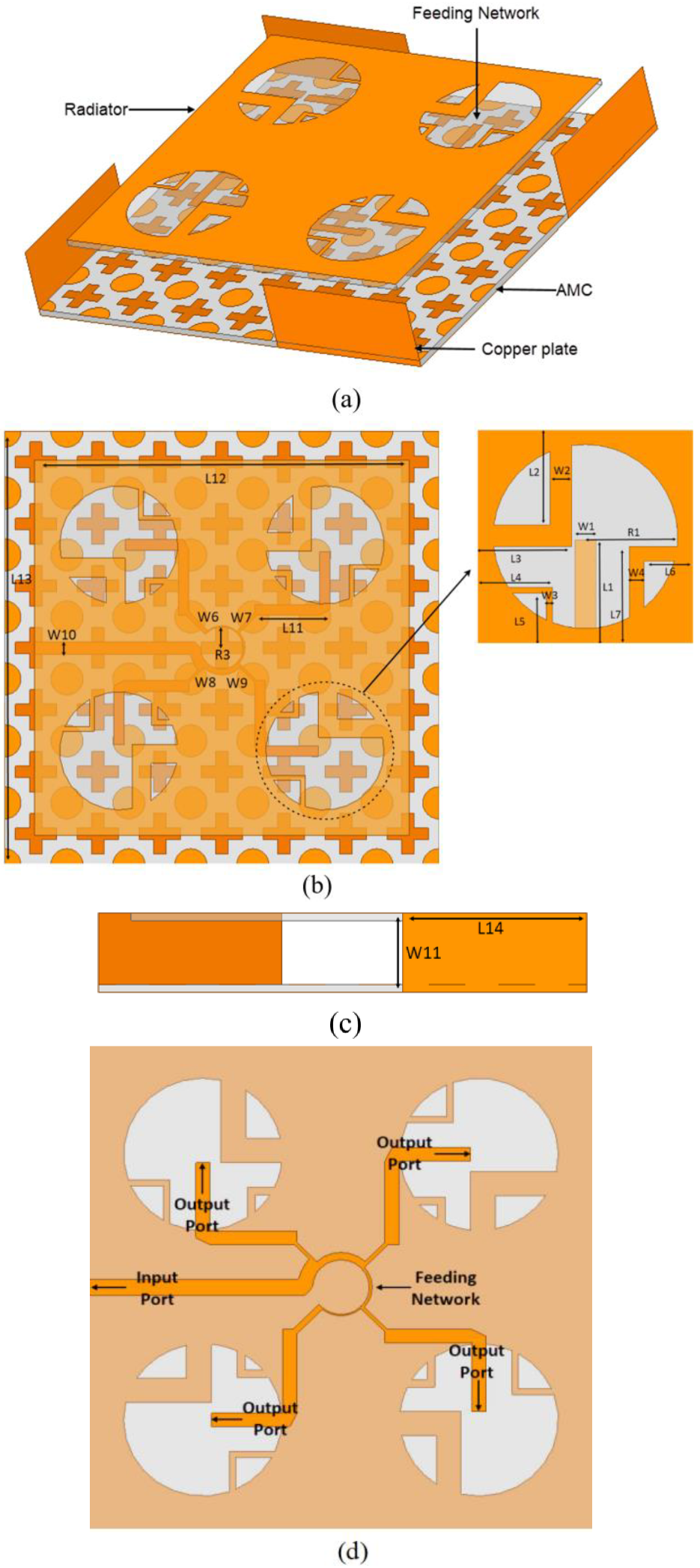

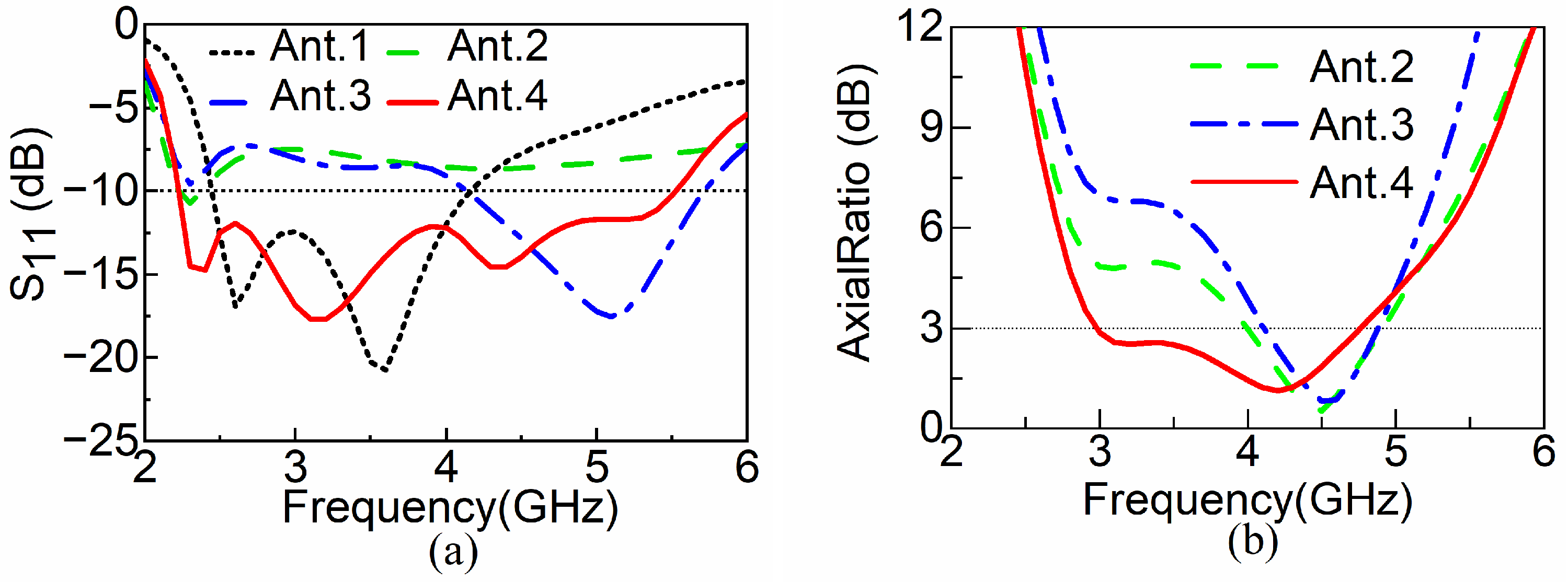
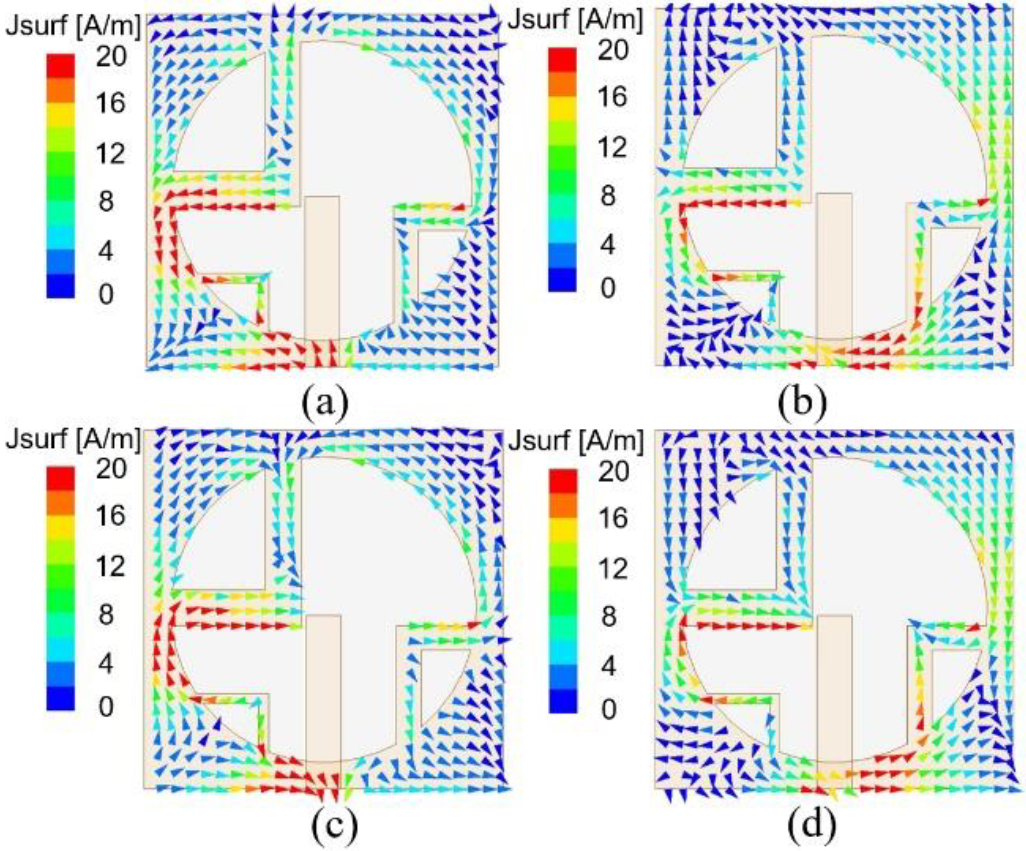
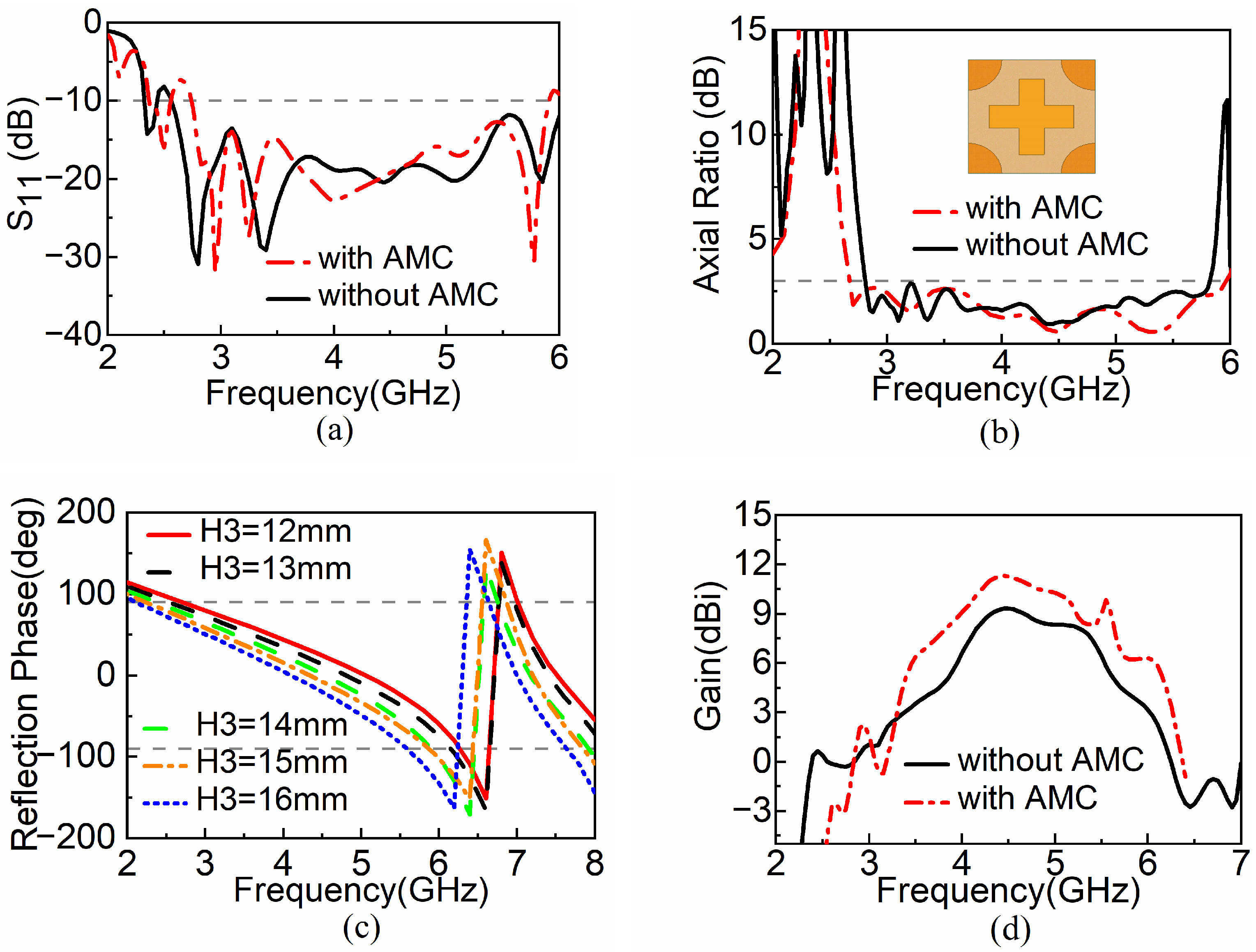
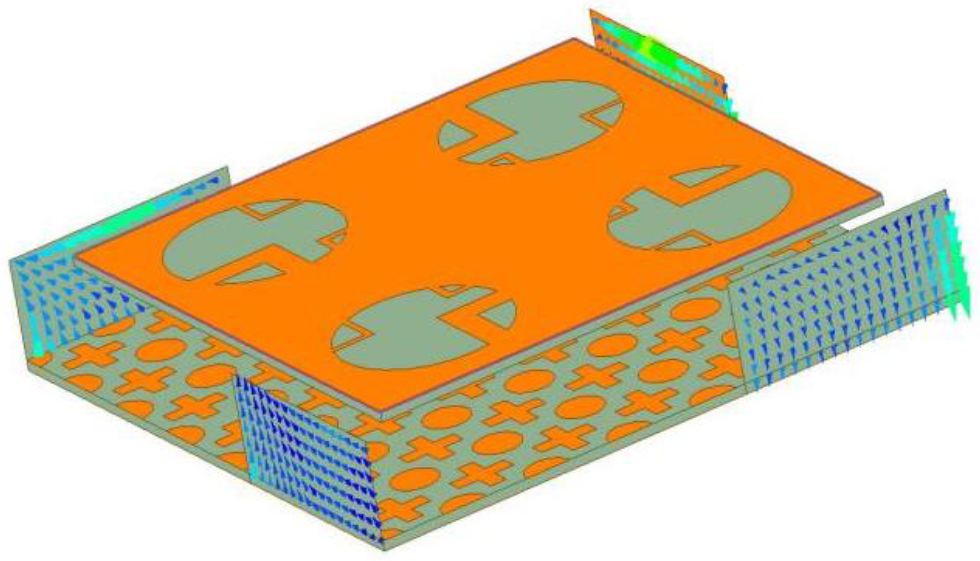
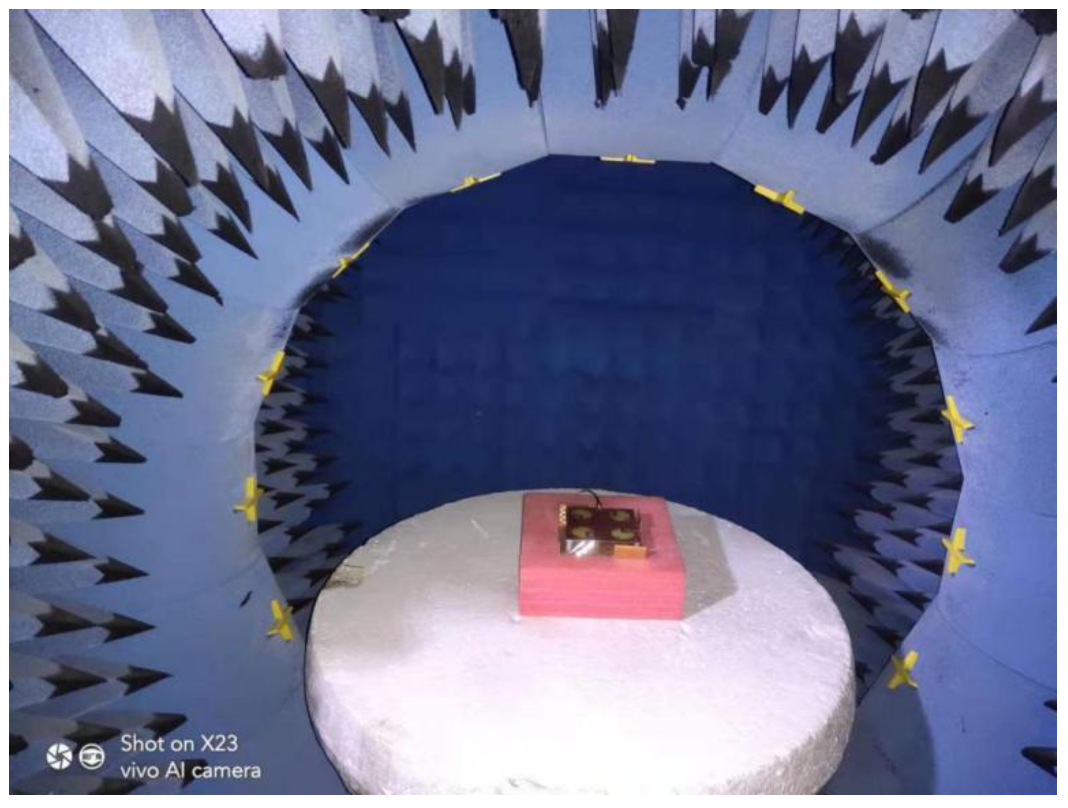
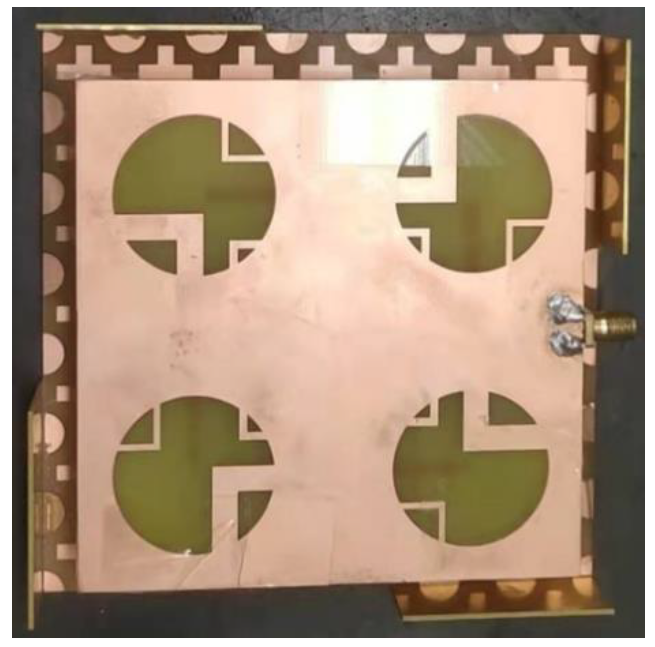
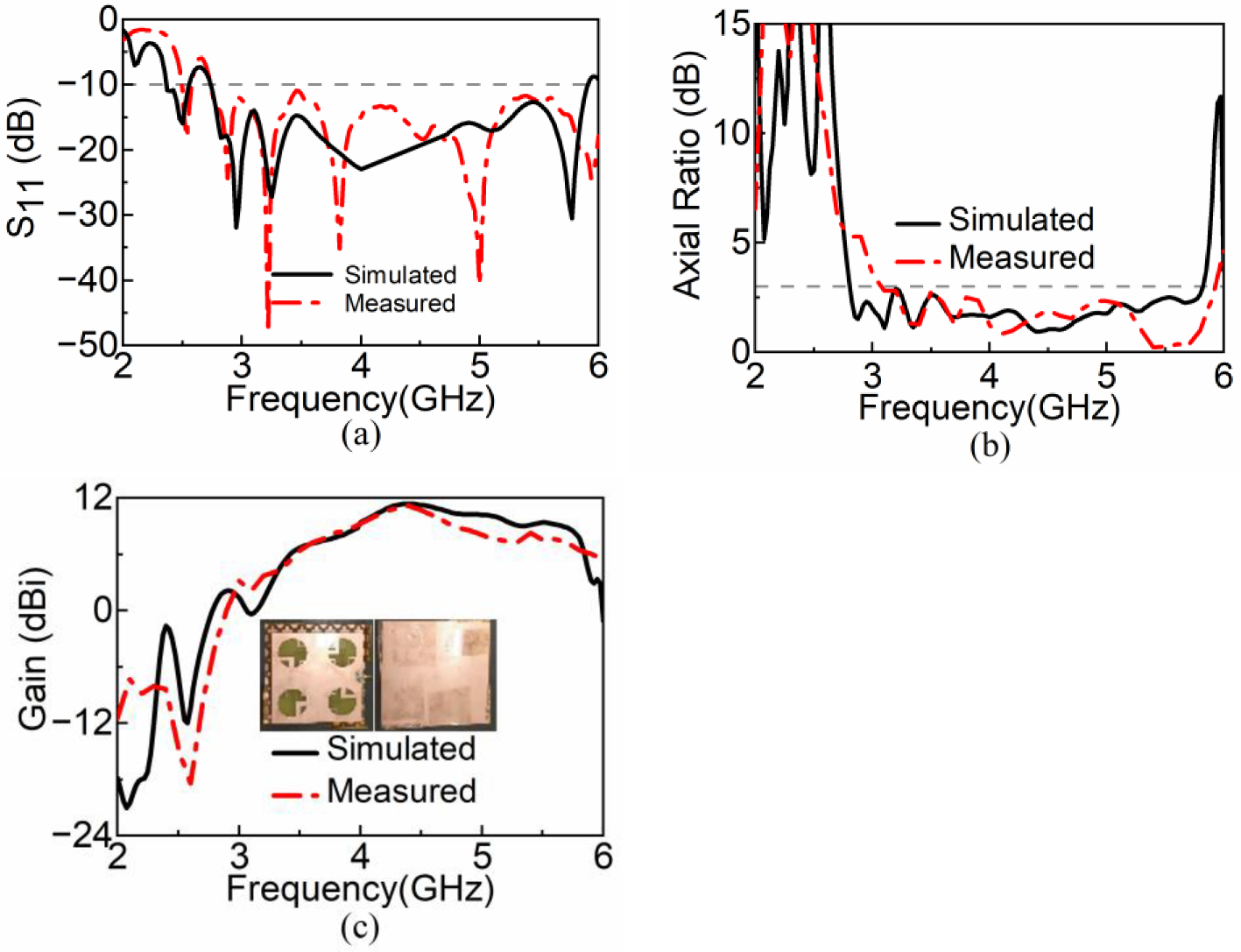
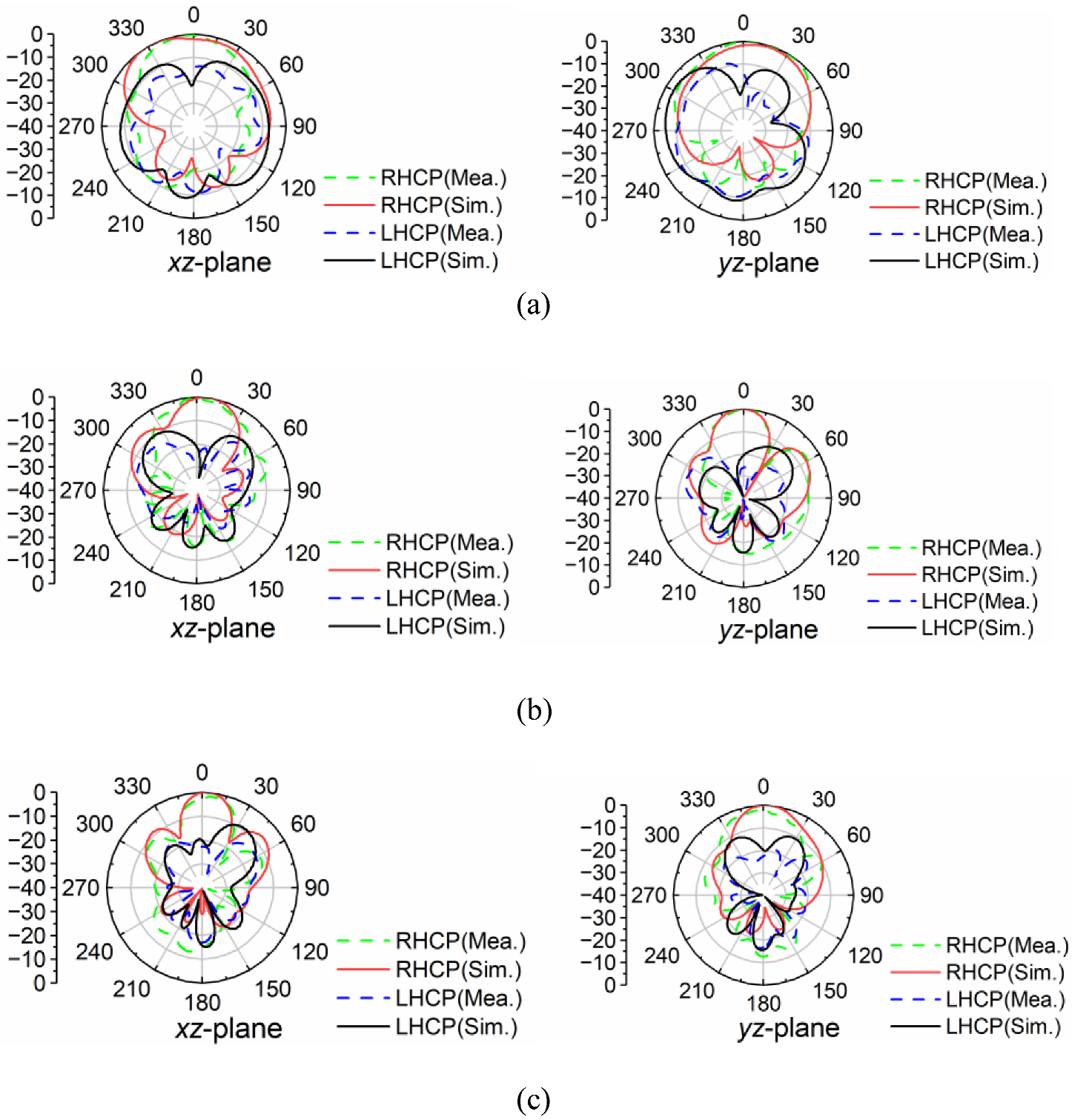
| Ref. | Size (λ0) | Substrate | IBW (%) | ARBW (%) | Peak Gain (dBi) |
|---|---|---|---|---|---|
| [9] | 1.02 × 1.02 × 0.028 at 5.5 GHz | Rogers 5880 | 25.8 | 20.6 | 8 |
| [10] | 1.45 × 1.45 × 0.028 at 5.4 GHz | Rogers 5880 | 15.9 | 11.8 | 12.5 |
| [11] | 1.43 × 1.43 × 0.032 at 6.15 GHz | FR4 | 37.4 | 27.6 | 10 |
| [12] | 1.67 × 1.67 at 5.4 GHz | FR4 | 52 | 31 | 7.5 |
| [14] | 2.07 × 1.79 × 0.01 at 5.6 GHz | FR4 | 78.5 | 35.7 | 14.2 |
| [15] | 0.4 × 0.4 at 1.63 GHz | Rogers 4003 | 31.9 | 21.56 | 5 |
| [18] | 2.02 × 2.33 × 0.18 at 6.16 GHz | FR4 | 64.28 | 54.28 | 10.84 |
| [19] | 1.72 × 1.72 × 0.22 at 7.55 GHz | Rogers 5870 | 55 | 54.9 | 12.1 |
| [21] | 0.86 × 0.86 × 0.03 at 5.75 GHz | FR408 | 29 | 15.5 | 8.25 |
| [24] | 1.26 × 1.26 × 0.046 at 5.9 GHz | Rogers 4003 | 55.6 | 41.67 | 12.08 |
| [25] | 1.64 × 1.64 × 0.072 at 6.15 GHz | F4B, Duriod | 62.7 | 56.7 | 14.1 |
| [27] | 1.6 × 1.6 × 0.065 at 9.6 GHz | Rogers 4003 | 41.45 | 33.16 | 13.5 |
| [28] | 1.85 × 1 at 5.15 GHz | F4B | 74 | 49.5 | 10.2 |
| [31] | 0.12 at 1.78 GHz | FR4 | 66.7 | 44.7 | 6 |
| [33] | 1.63 × 1.63 × 0.13 at 2.5 GHz | FR4 | 28.4 | 23.6 | 13 |
| [34] | 0.4 × 0.4 × 0.17 at 1.5 GHz | FR4 | 66.2 | 47.8 | 7.1 |
| [36] | 1.21 × 1.75 at 6.8 GHz | Rogers 4003 | 34.38 | 15.17 | 12.15 |
| [37] | 1×1×0.07 at 5.5GHz | F4B | 28.2 | 20.9 | 9.7 |
| This Work | 1.31 × 1.31 × 0.21 at 4.5 GHz | FR4 | 77.67 | 69 | 11.1 |
Disclaimer/Publisher’s Note: The statements, opinions and data contained in all publications are solely those of the individual author(s) and contributor(s) and not of MDPI and/or the editor(s). MDPI and/or the editor(s) disclaim responsibility for any injury to people or property resulting from any ideas, methods, instructions or products referred to in the content. |
© 2023 by the authors. Licensee MDPI, Basel, Switzerland. This article is an open access article distributed under the terms and conditions of the Creative Commons Attribution (CC BY) license (https://creativecommons.org/licenses/by/4.0/).
Share and Cite
Hao, H.; Wang, S.; Gao, H.; Ma, X.; Huang, X. Low-Cost Broadband Circularly Polarized Array Antenna with Artificial Magnetic Conductor for Indoor Applications. Appl. Sci. 2023, 13, 3104. https://doi.org/10.3390/app13053104
Hao H, Wang S, Gao H, Ma X, Huang X. Low-Cost Broadband Circularly Polarized Array Antenna with Artificial Magnetic Conductor for Indoor Applications. Applied Sciences. 2023; 13(5):3104. https://doi.org/10.3390/app13053104
Chicago/Turabian StyleHao, Han, Shuqi Wang, Huanhuan Gao, Xia Ma, and Xiaojun Huang. 2023. "Low-Cost Broadband Circularly Polarized Array Antenna with Artificial Magnetic Conductor for Indoor Applications" Applied Sciences 13, no. 5: 3104. https://doi.org/10.3390/app13053104
APA StyleHao, H., Wang, S., Gao, H., Ma, X., & Huang, X. (2023). Low-Cost Broadband Circularly Polarized Array Antenna with Artificial Magnetic Conductor for Indoor Applications. Applied Sciences, 13(5), 3104. https://doi.org/10.3390/app13053104





